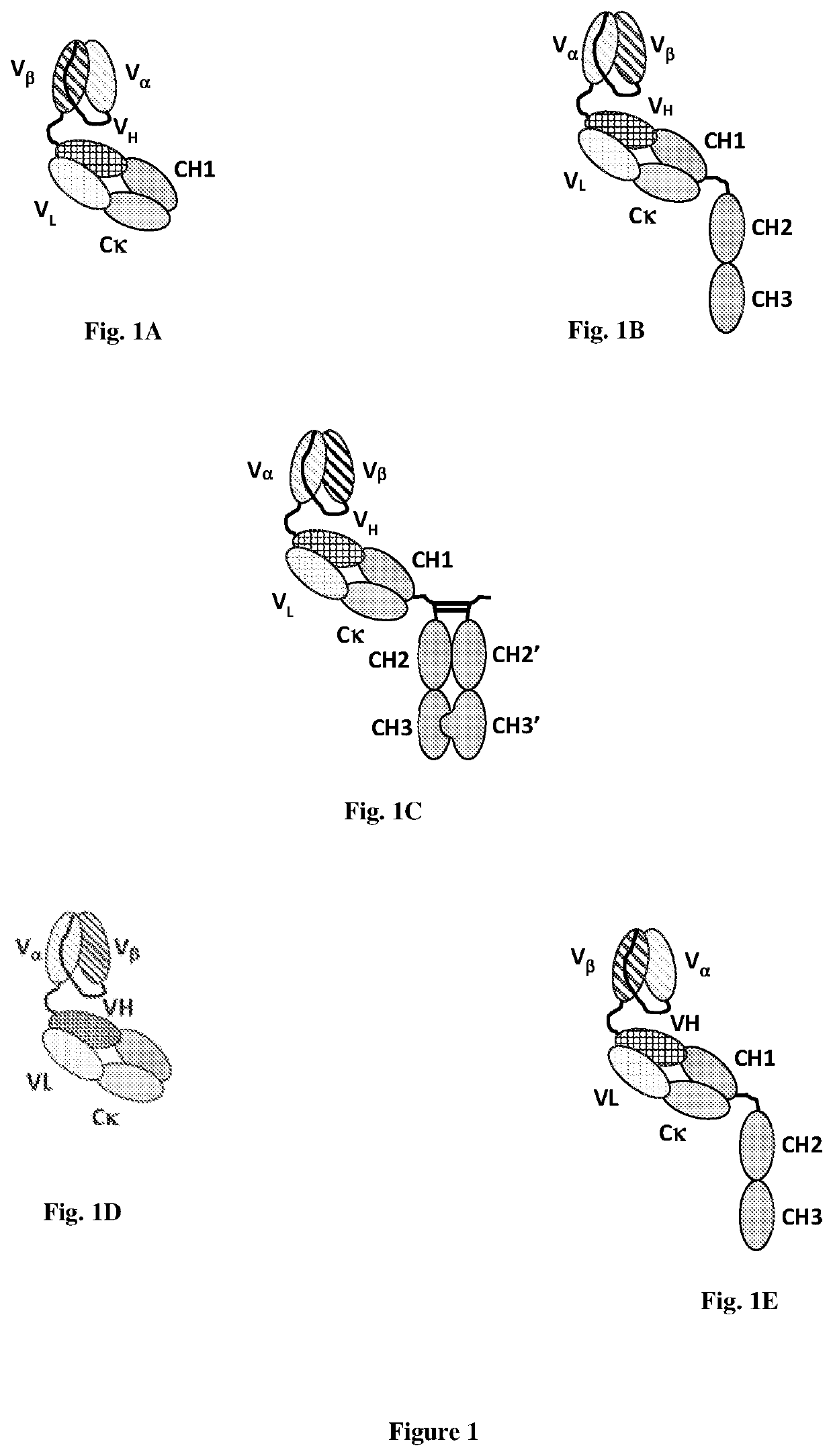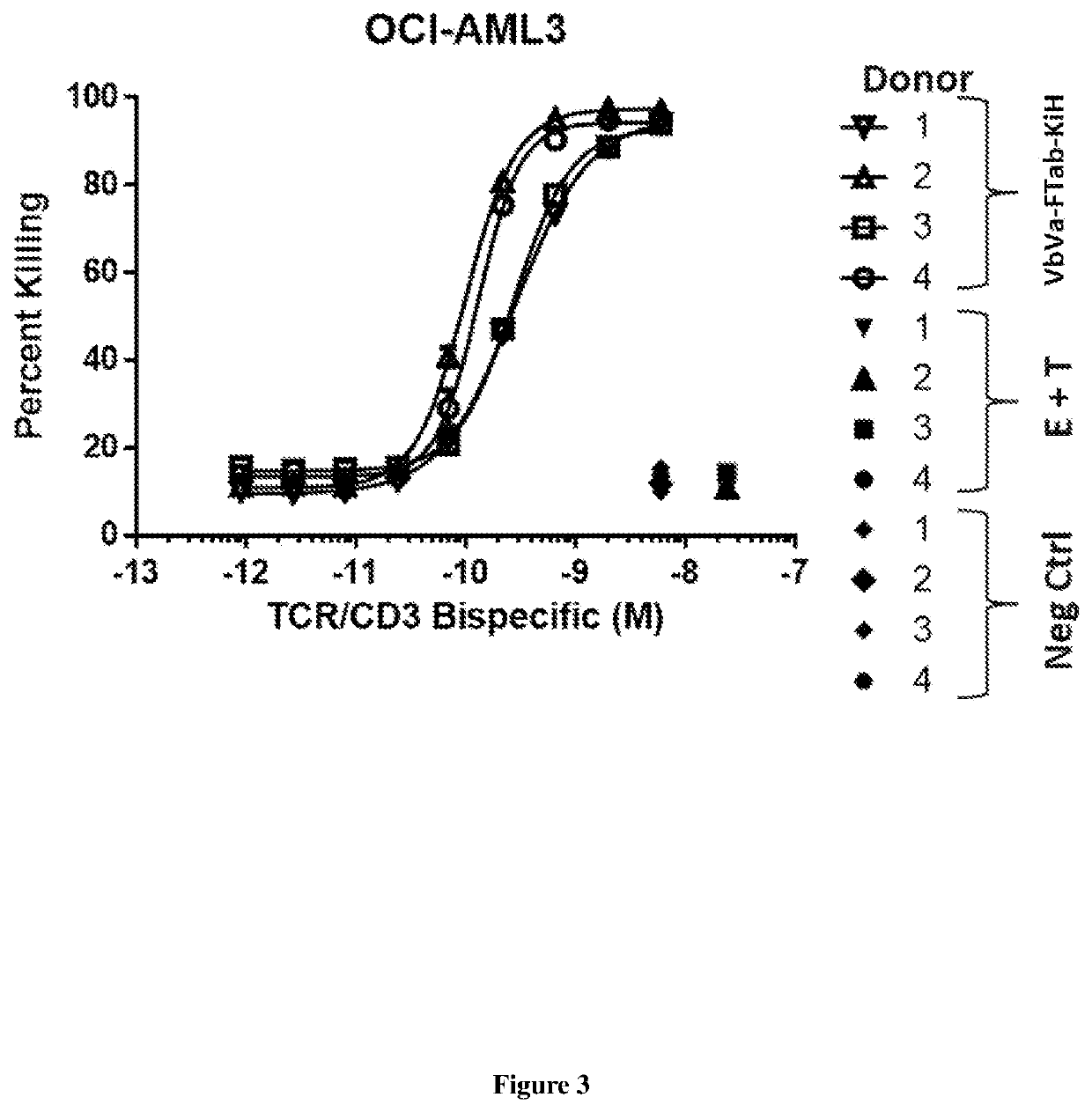Bispecific binding molecules
a technology of binding molecules and specific molecules, applied in the field of bispecific molecules, can solve the problems of many existing therapeutics, lack of selectivity of targeting cancer cells over healthy cells, and cancer cells' resistance to treatmen
- Summary
- Abstract
- Description
- Claims
- Application Information
AI Technical Summary
Problems solved by technology
Method used
Image
Examples
embodiments
[0090]Described herein are bispecific molecules that comprise a CD3 binding part that binds to human CD3 and a Survivin binding part that binds to human Survivin.
[0091]The term “human CD3” as used herein relates to human cluster of differentiation 3 protein (CD3) described under UniProt P07766 (CD3E-HUMAN).
[0092]The term “human Survivin” or “Survivin” as used herein relates to an inhibitor of apoptosis protein (IAP) described under UniProt O15392 (BIRC5_Human) which is a tumor-associated antigen that is expressed in human cancer cells.
[0093]“Binding to CD3 or human Survivin” refers to a molecule that is capable of binding CD3 or human Survivin with sufficient affinity such that the molecule is useful as a therapeutic agent in targeting CD3 or human Survivin.
[0094]Survivin Binding Part
[0095]In one embodiment, Survivin binding part of the bispecific molecules of the present invention refers to a single-chain soluble T cell receptor (sTCR).
[0096]The term “T cell receptors (TCRs)” as us...
example 1
ispecific Molecule Generation
[0691]Bispecific molecules were generated. The polypeptide sequence of each component of the bispecific molecules is listed in Table 1, and the DNA sequence encoding such polypeptide is identified. CDRs within such polypeptides are underlined and their sequences are separately identified.
[0692]In some embodiments, the polypeptide sequence of CH2CH3, CH2′CH3′, CH1CH2CH3, Heavy Chain 1 and / or Heavy Chain 2 components of the bispecific molecules listed in Table 1 lack the C-terminal lysine, resulting in a C-terminal glycine residue.
[0693]In some embodiments, the polypeptide sequence of CH1 component of VαVβ-FTab, Vβ Vα-FTab-1, Vβ Vα-FTab-2, or Vβ Vα-FTab-3 listed in Table 1 further includes a 6-His tag (HHHHHH, SEQ ID NO: 90) placed at the C-terminus of the CH1 domain for these bispecific molecules.
TABLE 1BispecificComponentAmino Acid SequenceDNA SequenceVβVα-FTab-KiHVβ - VαSEQ ID NO: 1SEQ ID NO: 41LinkerGGGGSGGGGSGGGGSGGGGSVα - VHSEQ ID NO: 1SEQ ID NO: 41L...
example 2
n and Purification
[0694]Plasmid DNA was provided internally, and protein was expressed in HEK293-6E cells using a transient transfection method. 0.5 mg DNA per liter cell culture was transfected into HEK293-6E cells at a density of 1.4×106 cells / mL using Polyethylenimine Max (PEI Max, Polysciences Inc) at a PEI:DNA ratio of 4:1 and Light Chain:Heavy Chain DNA ratio of 3:2. HEK293-6E cells were grown in FreeStyle™ 293 medium (Invitrogen) in suspension with 5% CO2 at 37° C., in 2.8 L shaking flasks (125 RPM). Cells were fed with 0.5% Tryptone N1 one day after transfection. On day 7 post-transfection, the transfected cell cultures were cleared by centrifugation followed by filtration through 0.2 μm PES filter (Corning).
[0695]Expression of bispecific molecules: All bispecific proteins of Example 1 were expressed in HEK293-6E cells using a transient transfection method. 0.5 mg DNA per liter cell culture was transfected into HEK293-6E cells at a density of 1.4×106 cells / mL using Polyethyl...
PUM
| Property | Measurement | Unit |
|---|---|---|
| size | aaaaa | aaaaa |
| resistance | aaaaa | aaaaa |
| affinity | aaaaa | aaaaa |
Abstract
Description
Claims
Application Information
 Login to view more
Login to view more - R&D Engineer
- R&D Manager
- IP Professional
- Industry Leading Data Capabilities
- Powerful AI technology
- Patent DNA Extraction
Browse by: Latest US Patents, China's latest patents, Technical Efficacy Thesaurus, Application Domain, Technology Topic.
© 2024 PatSnap. All rights reserved.Legal|Privacy policy|Modern Slavery Act Transparency Statement|Sitemap



